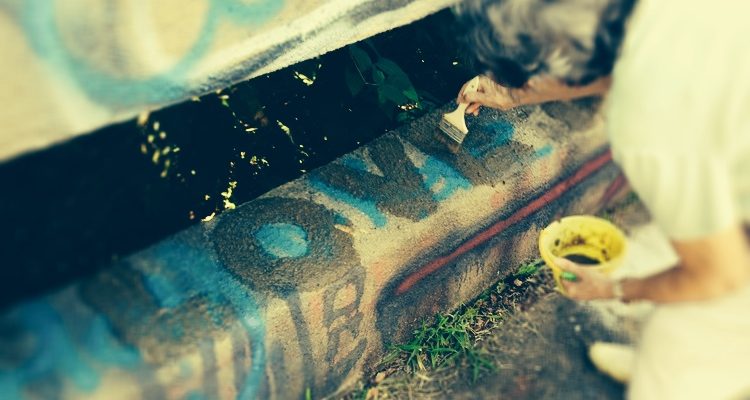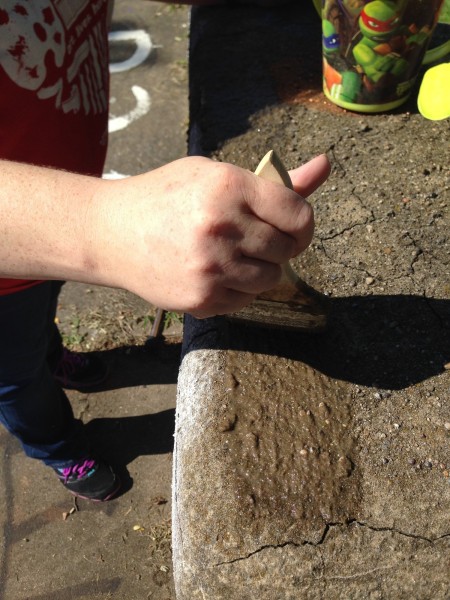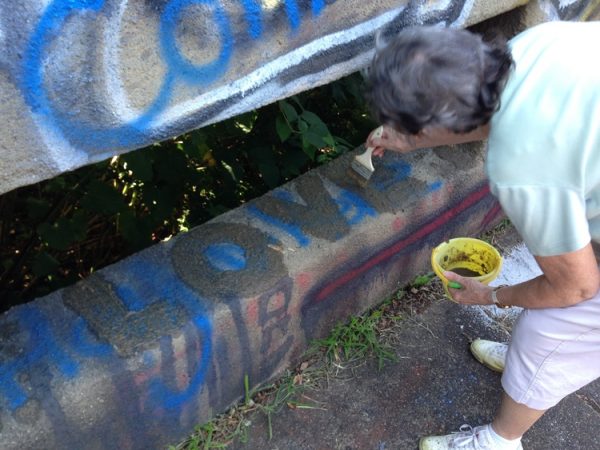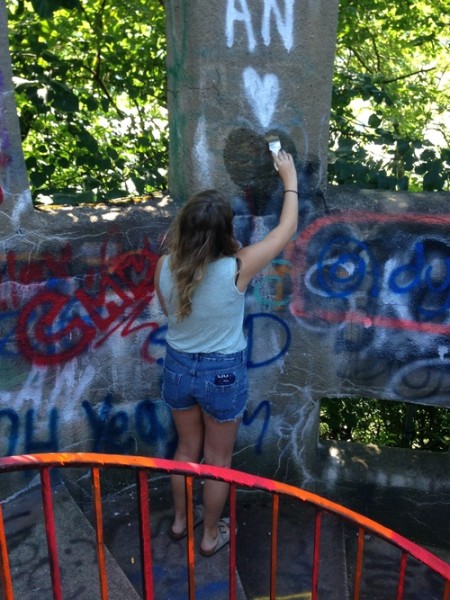A Weelunk Partnership with Dateline:Wheeling.
For more great Lee Chottiner stories, poetry and images that focus on Wheeling, WV, click the link below:
Volunteers try new way to check graffiti at Mt. Wood Overlook
Faced with an out-of-control graffiti problem at the Mt. Wood Overlook, volunteers are turning to a new method to keep the vandalism under control: moss.
Eleven volunteers, organized by the Wheeling Arts and Cultural Commission, converged Saturday morning at the Overlook, also known as the Castle, to test a buttermilk/moss-based solution that is meant to grow moss on concrete walls and thwart graffiti artists. Adults and children alike spread out around the grounds to dab parts of the stonework with the slurry.
They will return every couple of days to spray the “patches’ with water. If moss grows, they will have a new way to cover graffiti and discourage vandals from tagging the walls with spray paint.
Moss has been used in other cities to control graffiti. It has even become the basis for a unique from of urban art. Donaghy envisions moss art taking hold at the Overlook, too, if the test is successful.
The Overlook is ground zero for the city’s graffiti problem, which Dateline: Wheeling covered in its June 25 posting.
Erika Donaghy, chair of the Arts and Cultural Commission, said volunteers were applying the moss slurry to shaded and sunny parts of the Overlook to see how it works under both conditions. They were also applying it in various different shapes.
“We’re going to do some stencils, free hand [and] geometric shapes,” she said. “We’re going to test it in different areas.”
She said volunteers will return to the Overlook periodically to spray the patches with water “until we see growth. I hope we don’t get any downpours. We don’t want it to wash away; we want it to remain moist.”
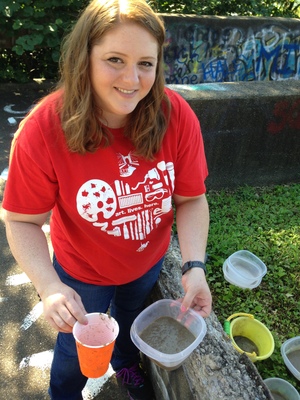
Heather Slack, Josh Banyo, and Patricia Croft mixed about 10 gallons of thick, gray slurry for the test.
Erika Donaghy shows off the slurry solution as she pours it in to plastic containers and passes them out to volunteers to go painting.
According to Slack, who was there to apply the slurry with her son, Victor, the recipe consisted of two cups buttermilk, two handfuls of moss, one-half teaspoon of sugar and water retention gel from a disposable diaper.
She said the gel, which thickens the slurry and prevents dripping, also encourages moss growth.
“We just got it [the diaper] wet really quick, cut it open and put it right into the mix. If you get it too wet, it won’t absorb anymore,” said Slack, a member of the Arts and Cultural Commission.
They found the recipe on—where else—the Internet.
“It was too soupy,” Slack said of the original recipe, “but there was a blog, and that’s where we got the idea to use the water retention gel.”
Most volunteers used the slurry to paint gray rectangles, hearts and other shapes. Others got more creative.
Jeanne Finstein, for instance, painted “love” on one of the Castle’s windowsills. She said she chose that word “rather than the….” Her voiced trailed off, alluding to some of the more colorful language painted there.
Donaghy said there appears to be renewed interest in restoring the Overlook and making it a destination attraction. She is talking to the Wheeling Area Heritage Corporation about tying the project to work being done at the Mt. Wood Cemetery, and she said the city is supporting the commission’s work there and plans to trim the vegetation around the Castle’s walls.
“We just had to wait for the right time, the right idea and the right group of people to tackle it,” she said.
Photos by Lee Chottiner
Lee Chottiner is an award-winning professional journalist who makes his home in Wheeling. A graduate of the American University in Washington, D.C., and Point Park University in Pittsburgh, Lee is a 30-year veteran of newspapers, including eight years at the Dominion Post in Morgantown. There, Lee covered the West Virginia Legislature, municipal government, state and federal courts, higher education and environmental affairs.
For the past 13 years, Lee was the executive editor of The Jewish Chronicle, a Pittsburgh-based publication that covered Jewish-related news in western Pennsylvania, West Virginia and around the world.

Lee has won numerous writing awards including three from the West Virginia Press Association for municipal coverage, investigative reporting and enterprise writing. The Pennsylvania Newspaper Publishers’ Association, the Press Club of Western Pennsylvania, The Alliance for the Mentally Ill and the American Jewish Press Association have also honored him.
Also a creative writer, Lee’s poetry has appeared in several publications, and he has just finished editing an anthology of poetry, essays, art and photography for Classrooms Without Borders, an organization that sends students and teachers to Europe to study the Holocaust and its impact on tolerance and reconciliation.
Lee lives in Woodsdale with his wife, Rabbi Beth Jacowitz Chottiner, their daughter, Noa, and their basset hound, Guthrie.


